Athena Review Vol. 5, no. 1
Records of Life: Fossils as Original Sources
28. Theropods 2: Bird-like Dinosaurs
Theropoda
Romer (1956, 1966) subdivided the Order Saurischia into two suborders, Theropoda and Sauropoda. Theropods covererd in the previous section included the large carnivorous Carnosauria and Tyrannosauridae. The set of theropods examined here are known for their bird-like qualities: Troodontids, Dromaeosauridae, and Aviale, the latter the direct ancestors of birds.
Troodontids
Troodontids wre small, bird-like, gracile maniraptorans. All troodontids have many unique features of the skull, such as closely spaced teeth in the lower jaw, and large numbers of teeth. Troodontids have sickle-claws and raptorial hands, and some of the largest non-avian brains, indicating they had keen senses and muscular control. The group is named for Troodont ("wounding teeth"), distinctive small serrated teeth that were first described by Leidy in 1856, and now known to belong to a variety of related Troodontid species.
Saurornithoides
Saurornithoides ("bird-like lizard") was a relatively small Troodontid predator from the Late Cretaceous period. The type specimen S. mongoliensis was discovered in the Gobi Desert in July, 1923 during an expedition to Mongolia by the American Museum of Natural History (AMNH 6515). Originally, only one or two individuals of Saurornithoides were found within the same layer of the Djadochta Formation. The first find included a single skull and jaw (fig.1), vertebrae, a partial pelvis, hind limb and associated foot.
Saurornithoides resembled Velociraptor, another bird-like theropod who ran quickly on its hind legs and had excellent sight and hearing (described below). Saurornithooides had a
 skull length of 18.9 cm, with large eye sockets and stereoscopic
vision, allowing for good depth perception. It probably had good vision
in light and very good night vision. It had a long, low head, a
depressed muzzle, sharp teeth and a relatively large brain. Saurornithoides
presumably hunted small mammals and reptiles throughout the Gobi
Desert. Like other troodontids, it had an enlarged retractable
claw on the second toe of each foot.
skull length of 18.9 cm, with large eye sockets and stereoscopic
vision, allowing for good depth perception. It probably had good vision
in light and very good night vision. It had a long, low head, a
depressed muzzle, sharp teeth and a relatively large brain. Saurornithoides
presumably hunted small mammals and reptiles throughout the Gobi
Desert. Like other troodontids, it had an enlarged retractable
claw on the second toe of each foot.Fig.1: Skull of Saurornithoides mongolienses (AMNH 6515).
Dromaeosauridae
Dromaeosaurs ("running lizards") were small- to medium-sized theropods who first appeared in the Mid Jurassic period (167 mya), and continued to flourish through the Late Cretacous (90-66 mya). They included some bird-like forms, as well as "raptor" species of small, agile carnivores with long, slender limbs and hands. Some dromaeosaurids were feathered theropod dinosaurs. Dromaeosaurid fossils have been found worldwide, in North and South America as well as in Europe, Africa Asia, and Antarctica.
Velociraptor
Velociraptor ("speedy plunderer") was a relatively small but agile, bipedal Dromaesaurid dinosaur dating from the Late Cretaceous period (75-71 mya). The type species is Velociraptor mongoliensis, recovered from a 1923-4 expedition to Mongolia by the American Museum of Natural History (AMNH), and described by Osborn (1924). A second species found in Inner Mongolia, V. osmolskae, was described by Godefroit et al. in 2008.
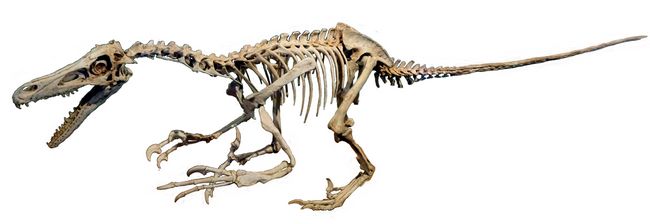
Fig.2: Skeleton of Velociraptor mongoliensis (AMNH).
Velociraptor was a predator about 1 meter long who ran very quickly on two legs, and may have hunted in packs. Like other Dromaesaurids, it had long, thin arm bones and fingers, and a long tail. It had an enlarged, retractable, sickle-shaped claw on the second toe of each foot, presumably used to disembowel its prey (fig.2).
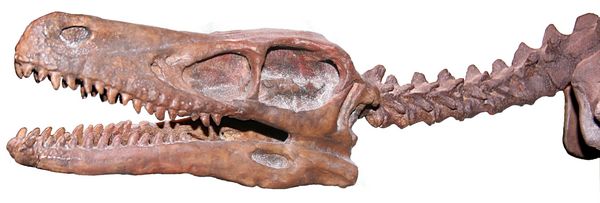
.
Velociraptor can be distinguished from other Dromaeosaurids by its long and low skull, with an upturned snout (fig.3) The Velociraptor endocranium shows a relatively large brain, typical of the Dromaesaurids and the Troodontids. Their large eyes indicate noctural hunting habits. The skull here shown was found in Rehe, Liaoning Province, China, and was exhibited as a cast in the 2013 Chinasaurs Exhibit in the US.
Fig.3: Skull and neck vertebrae of Velociraptor (Chinasaurs Exhibit, cast; photo: Athena Review)
Bambiraptor
Bambiraptor was a Late Cretaceous (72 mya), bird-like Dromaeosaurid dinosaur. The Bambiraptor holotype skeleton, representing a juvenile with a total length of
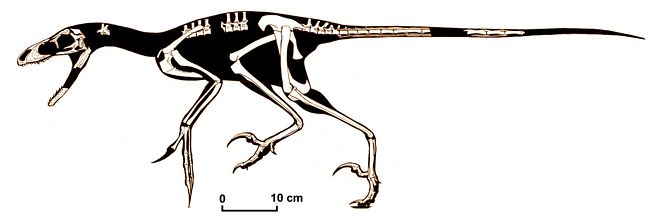 1 meter,
was discovered in 1993 near Glacier National Park in Montana by a
teenage fossil collector. Adult specimens have also been found,with
adult body length estimated at 1.3 m, with a weight of five kg. It had
long hindlimbs, indicating it could have been a fast runner, and very
long arms.
1 meter,
was discovered in 1993 near Glacier National Park in Montana by a
teenage fossil collector. Adult specimens have also been found,with
adult body length estimated at 1.3 m, with a weight of five kg. It had
long hindlimbs, indicating it could have been a fast runner, and very
long arms.Fig.4: Skeleton of Bambiraptor feinbergi (AMNH, after Burnham et al. 2000).
Bambiraptor had a relatively large brain size, in the lower range of modern birds. The Bambiraptor holotype had with 14 cm³ the largest brain for its size of any dinosaur yet discovered, although the brain size may be due to its age, because juvenile animals tend to have larger brain-to-body ratios compared to adults.
Because of its enlarged cerebellum, which ma
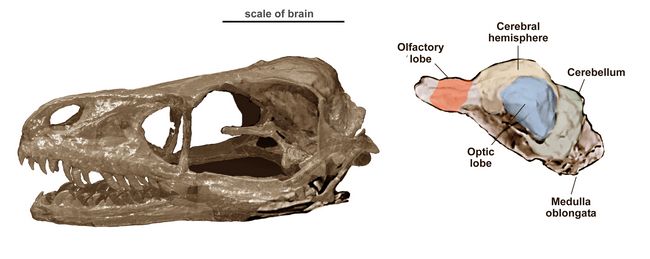 y indicate higher agility and
higher intelligence than other dromaeosaurs, Burnham et al.
(2000) proposed that Bambiraptor
may have been arboreal. Life in the trees may have required
evolutionary pressure that resulted in a larger brain. An alternative
hypothesis is that a larger brain could be selected for as a result of
hunting more agile prey items such as lizards and mammals.
y indicate higher agility and
higher intelligence than other dromaeosaurs, Burnham et al.
(2000) proposed that Bambiraptor
may have been arboreal. Life in the trees may have required
evolutionary pressure that resulted in a larger brain. An alternative
hypothesis is that a larger brain could be selected for as a result of
hunting more agile prey items such as lizards and mammals.Fig.5: Skull and brain endocast of Bambiraptor feinbergi (after Burnham et al. 2000).
Avialae
Avialae ("bird wings") is a group of flying dinosaurs ancestral to birds. The earliest avialans known are from the late Jurassic Tiaojishan Formation of China, dated to the Oxfordian stage, about 160 million years ago. The avialan species from this time period include Anchiornis huxleyi and Aurornis xui. Archaeopteryx, the best known early bird ancestor, dates from about 15 million years later during the Late Jurassic. Avialans then diversified into a wide variety of forms during the Cretaceous Period. Many groups retained primitive characteristics, such as clawed wings and teeth, though the latter were lost independently in modern birds (Aves).
Archaeopteryx
Archaeopteryx ("ancient wing") were bird-like dinosaurs, with many traits shared with the contemporary theropod groups dromaesauridae and troodontids, showing Archaepteryx to be clearly transitional between non-avian feathered dinosaurs and modern birds. The type species, Archaeopteryx lithographica (fig.6), dating from the late Jurassic Period (145 mya), was found in 1861 as a limestone cast in the Solnhofen Formation of Germany. Ten more examples have since been found in Germany and Portugal, representing a period when Europe
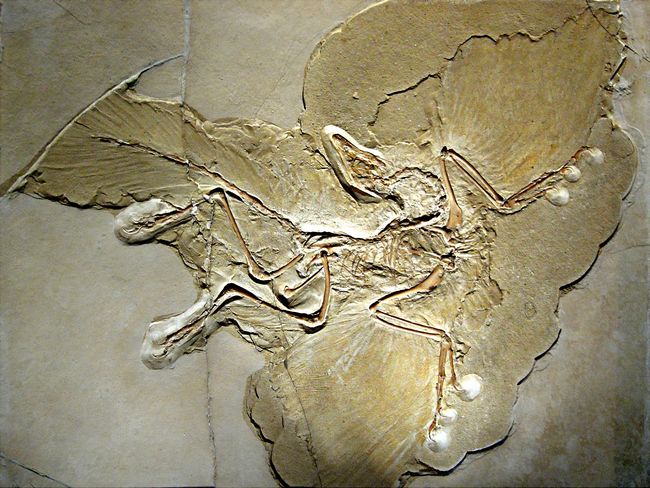 had a much warmer climate than now, and was an
archipelago of islands in a shallow tropical sea.
had a much warmer climate than now, and was an
archipelago of islands in a shallow tropical sea.Archaeopteryx is the earliest known avialan which may have had the capability of powered flight. Many early avialans shared unusual anatomical features that may be ancestral to modern birds, but were later lost during bird evolution. These features include enlarged claws on the second toe which may have been held clear of the ground in life, and long feathers or "hind wings" covering the hind limbs and feet, which may have been used in aerial maneuvering.
Fig.6: Fossil of Archaeopteryx lithographica
The largest species of Archaeopteryx could grow up to a half meter in length, about the size of a raven or large crow. Despite their relatively small size and feathered wings, Archaeopteryx had more in common with other small Mesozoic dinosaurs than with modern birds. They shared various traits with dromaeosaurids and troodontids, including jaws with sharp teeth, three fingers with claws, hyperextensible second toes (known as "killing claws"), feathers (which also suggest warm-bloodedness), and various features of the skeleton including a long bony tail. Subsequently, the tails of more advanced avialans were shortened with the advent of the pygostyle bone in the group Pygostylia. In the late Cretaceous, around 95 million years ago, the ancestor of all modern birds also evolved a larger olfactory lobe, indicating an improved sense of smell.
References:
Burnham, D.A., K.L. Derstler and W. Linster 1997, A new specimen of Velociraptor (Dinosauria: Theropoda) from the Two Medicine Formation of Montana. Dinofest International Proceedings. pp 73-75
Burnham, D.A., K.L. Derstler, P.J. Currie, R.T. Bakker, Z.Zhou Z. & J.H. Ostrom 2000. Remarkable new birdlike dinosaur (Theropoda: Maniraptora) from the Upper Cretaceous of Montana. University of Kansas Paleontological Contributions 13: 1-14
Chinasaurs Exhibit. 2013.
Godefroit, P., P. Currie, H. Li, C-Y Shang, Z. Dong 2008. A new species of Velociraptor (Dinosauria: Dromaeosauridae) from the Upper Cretaceous of northern China. Journal of Vertebrate Paleontology. 28 (2): 432–438.
Osborn, Henry F. 1924. Three new Theropoda, Protoceratops zone, central Mongolia. American Museum Novitates. 144: 1–12..
Glossary